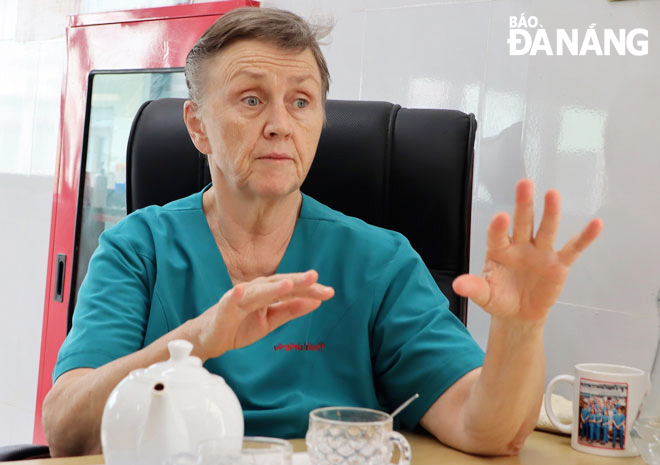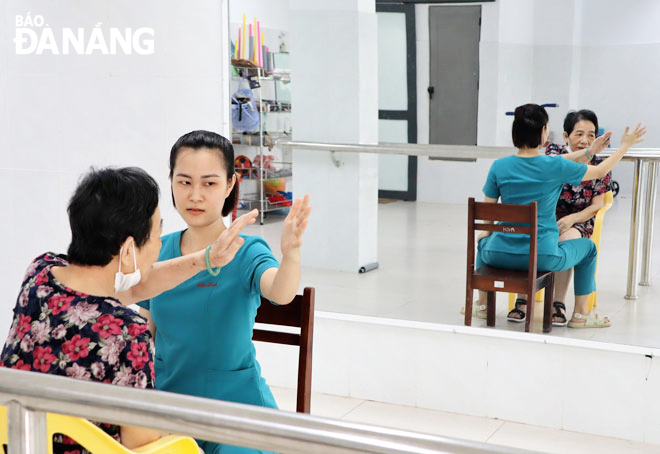Exceptional "dance moves" reflected in the mirror
It is surprising when entering a room of the Rehabilitation Department at the Da Nang Traditional Medicine Hospital since the four sides are mirrors reflecting all physical therapy activities of patients, technicians, and doctors. With no rush, no noise, just having arms slowly going up and down, feet trying to walk evenly and shoulders trying to be balanced on one axis. Without the presence of hospital clothes, it would have looked more like a ballet studio than a post-stroke treatment room.
 |
| Virginia Mary Lockett, American Physiotherapist |
Therapy for post-stroke patients
On the daily basis, no matter how rainy or sunny it is outside, technicians here have diligently assisted patients in practising rehabilitation. As shared by technician Ho Thi Cam Linh, when the patient exercises, the observation through the mirror creates functional images that are memorized in the motor and premotor cortex, stimulating nerve cells to mimic moves to restore the dexterity of the paralyzed limbs. Moreover, the practice with a mirror is definitely simple and easy for patients to practice at home after the treatment period at the hospital.
60-year-old architect Vo Duy Linh residing on Tran Cao Van Street in Da Nang seemed to be unable to survive after a stroke and was severely affected by COVID-19. After that, Mr Linh underwent 2 rehabilitation function treatments at the hospital. Although his voice is currently still limp, his limbs have begun to be flexible and he can walk on his own as well as control some personal activities.
“We only see how precious health is when we are in the hospital for treatment. Even the simplest activities such as walking, talking, and eating have to be re-learned like a child," said Mr Linh.
"Dance" to find themselves again
Dr Tran Thi Ngoc Lanh, Head of Rehabilitation Unit at Da Nang Traditional Medicine Hospital, added: “Patients with stroke often have a bunch of severe sequels, in which the reduction and loss of movement of the upper extremities, especially the hands, account for a large share. Therefore, improving motor function of the upper extremities and hands is a leading goal in stroke rehabilitation." In order to have good progress in treatment, the patient has to work hard to "interact" with the therapist a lot, that is, to persevere and practice according to the doctor's request.
65-year-old Ms Nguyen Thi Hong Minh living in Hoa Hai Ward, Ngu Hanh Son District, was hospitalized with sequelae of cerebral infarction and Parkinson's disease. At that time, not only did she have to use an iron frame to move, but she was also extremely pessimistic. After a course of "dance" instructed by technicians, she gradually found the feeling in her legs. At that
moment, she was so happy that she burst into tears.
 |
| Ms. Nguyen Thi Hong Minh "dances" in front of the mirror with technician Ho Thi Cam Linh. Photo: NHU HANH |
Besides, "dance therapy" has long become the "graduation" exam of post-stroke patients. This is considered a high-level exercise for a group of patients having good progress and being about to be discharged from the hospital. In order to "dance" in a group, the patient must achieve the flexibility of the arms, legs and whole body, and know how to coordinate with the dance partner in the background of music. It was not an easy test, but it was the desire to find themselves through the dance steps that made these special dancers apply themselves diligently towards a definite goal.
|
"While the technicians persistently guide patients to practice the movements in front of the mirror, I and other doctors, and physiotherapists have silently watched the practice so that we could change the exercise programs if needed as being creative in treatment helps patients achieve the highest treatment results in the fastest time. The physician must instil trust in the patient by caring, eye contact, gesture and finding many ways to communicate with them to create effective treatment.” Virginia Mary Lockett, American Physiotherapist |
“New breeze” in rehabilitation treatment
For nearly 12 years, not only has the American Physiotherapist and volunteer Virginia Mary Lockett directly examined and treated thousands of recovered patients, but she has also trained dozens of doctors and hospital technicians to enhance their skills. On top of that, she also spent her own money to buy exercise equipment and helped many patients in the Central Region of Viet Nam.
On the daily basis, she always presents in the treatment room, quietly observes the patient's practice and carefully records every happening. Her presence seems like a clear mirror of a well-mannered person for hospital staff to look at and keep working whenever they are exhausted and discouraged.
“ Ms Virginia Mary Lockett has given the hospital a new breath of fresh air through her scientific, devoted, creative way of working and a kind heart, treating patients like her family members,” said Dr Nguyen Van Anh, Director of Da Nang Traditional Medicine Hospital.
In addition, the American expert also had the initiative to use cloth belts tied across the patient's back so that the technician can grasp the belt and pull it slightly back whenever the patient lost balance to ensure safety while exercising. When asked about her feelings when the unit moved to a new facility on Dinh Gia Trinh Street, Cam Le District, Ms Lockett said: “I'm glad that the new facility has a much larger and more open rehabilitation room. That helps the patient have a better practice space, leading to better efficiency.
On the wall of Ms Virginia Mary Lockett's office is a photo of journalist V.T.L., taking her as a guide to therapy for a patient in the topic "Rehabilitation" published in Da Nang Newspaper on May 20th, 2018. She said, that time was "in" the newspaper, although she was a little surprised, she was very happy. It was the thinking about how to restore body functions more effectively for patients that made her propose to the hospital director to install a mirror, turning the Physiotherapy room into a place to practice "dances", contributing to helping the patients quickly find the old peaceful days.
Reporting by NHU HANH- Translating by T.VY